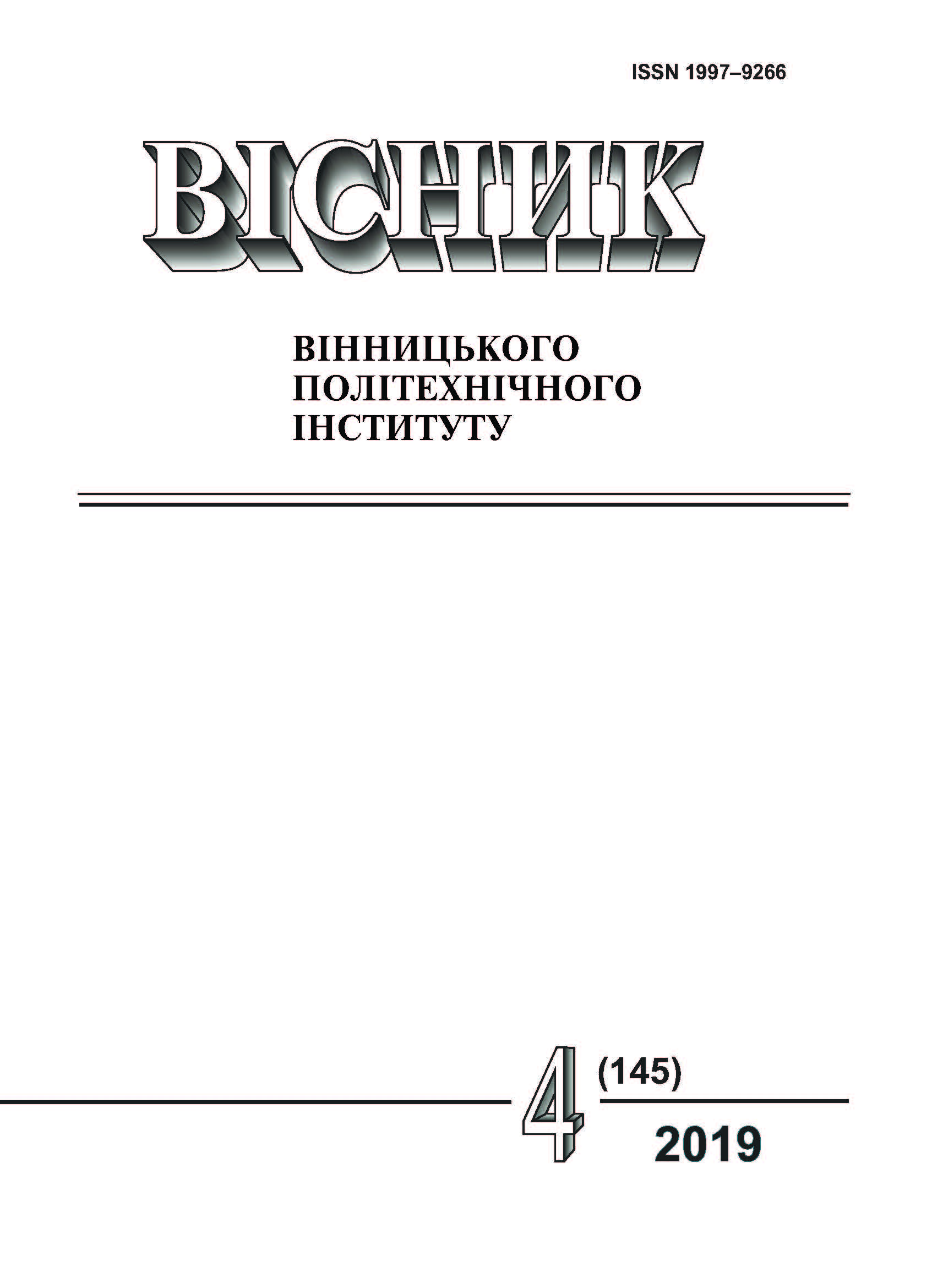РЕВЕРСИВНИЙ ГЕНЕРАТОР КОДОВИХ ПОСЛІДОВНОСТЕЙ НА FPGA
DOI:
https://doi.org/10.31649/1997-9266-2019-145-4-100-106Ключові слова:
реверсивний генератор кодових послідовностей, метод визначення функції збудження, гнучкі системи стеження, інтегральні мікросхеми жорсткої логіки, Altera, Quartus, IntelАнотація
Генератори кодових послідовностей (ГКП) широко використовуються в цифрових системах радіотехніки та зв’язку, обчислювальної техніки та автоматики для зберігання інформації і виконання арифметичних операцій, а також діагностування і корекції похибок цифрових пристроїв у ланцюгах керування і синхронізації. Серед різного типу ГКП набули поширення генератори псевдовипадкових чисел і генератори зі сталими кодами, в яких сполучення нулів та одиниць у розрядах регістра залишається незмінним. Послідовність називається псевдовипадковою, якщо вона виглядає, як безсистемна і випадкова, хоча насправді вона створювалась за допомогою суто детермінованого процесу, відомого під назвою псевдовипадкового генератора. Подібні генератори переважно задаються деяким початковим значенням і за допомогою певних алгоритмів отримують з нього випадкові послідовності кодів. В цьому сенсі псевдовипадкові генератори можна розглядати як розповсюджувачі випадковості. До основних недоліків таких пристроїв слід віднести те, що виконання зсуву здійснюється тільки праворуч, що зменшує функціональні можливості.
Авторами проведено аналіз сучасних методів реалізації генераторів кодових послідовностей та, враховуючи їх недоліки, запропоновано нове схемне рішення реверсивного генератора кодових послідовностей, яке дозволяє зменшити використовуваний ресурс інтегральних схем, оскільки побудований на регістрі довільної розрядності, і таким чином дає можливість утворювати вихідну шину довільної розрядності без зміни вихідного коду в точці реверсу. Описано метод визначення функції збудження для n-розрядного регістра зсуву та наведено приклад розрахунку чотирирозрядного регістра зсуву, що забезпечує автоматичне повернення до основного режиму роботи системи. Таке рішення дозволяє створювати гнучкі системи на основі стандартних інтегральних мікросхем жорсткої логіки. Подано результати моделювання схеми реверсивного генератора кодових послідовностей у програмному забезпеченні САПР Altera Quartus II з наведенням часових діаграм роботи пристрою.
Посилання
Q. Wang, and S. Yu, C. Guyeux, Design of Digital Chaotic Systems Updated by Random Iterations (SpringerBriefs in Applied Sciences and Technology), Springer, 1st ed. 2018 ed., 124 p., 2018. ISBN: 978-3319735481.
И. Н. Букреев, В. И. Горячев, и Б. М. Мансуров, Микроэлектронные схемы цифровых устройств 4-е изд., перераб. и доп. Москва, Россия: Техносфера, 2009.
Chaofan Yu, Lingli Wang and Xuegong Zhou, “Automatic layout generator for embedded FPGA cores,” in 2011 9th IEEE International Conference on ASIC, Xiamen, 2011, pp. 385-388. https://doi.org/10.1109/ASICON.2011.6157202 .
P. Pfeifer, F. Hosseinzadeh and H. T. Vierhaus, “On comparison of configurable encoders in Xilinx and Altera FPGAs,” 2017 International Conference on Applied Electronics (AE), Pilsen, 2017, pp. 1-4. https://doi.org/10.23919/AE.2017.8053605 .
Y. Ruan, Y. Tang, W. Yao, Z. Wang and S. Xu, “A single chip multi-functional DDS waveform generator based on FPGA with SOPC design flow,” Proceedings of the 10th World Congress on Intelligent Control and Automation, Beijing, 2012, pp. 4206-4210. https://doi.org/10.1109/WCICA.2012.6359183 .
Д. В. Гаврілов, О. В. Осадчук, та О. С. Звягін, Основи комп’ютерного проектування та моделювання РЕА. Частина 1, лабораторний практикум. Вінниця, Україна: ВНТУ, 2015.
Д. В. Гаврілов, О. С. Звягін, О. В. Осадчук, та А. Ю. Савицький. Основи комп’ютерного проектування та моделювання РЕА. Частина 2, лабораторний практикум. Вінниця, Україна: ВНТУ, 2017.
В. Л. Кофанов, О. В. Осадчук, Д. В. Гаврілов. Лабораторний практикум з цифрових пристроїв на основі САПР Quartus II. Вінниця, Україна: УНІВЕРСУМ, 2007.
Cetin Kaya Koc, Cryptographic Engineering, Springer, 2009 ed., 522 p., 2009. ISBN: 978-0387718163.
В. Л. Кофанов, О. В. Осадчук, та Д. В. Гаврілов. Лабораторний практикум з дослідження цифрових пристроїв на основі САПР MAX+PLUS II. Вінниця, Україна: УНІВЕРСУМ, 2006.
Esteban Tlelo-Cuautle, José de Jesús Rangel-Magdaleno, and Luis Gerardo de la Fraga, Engineering Applications of FPGAs: Chaotic Systems, Artificial Neural Networks, Random Number Generators, and Secure Communication Systems, Springer, 1st ed., 222 p., 2016, ISBN: 978-3319341132.
А. Ю. Воловик, Д. В. Гаврілов, А. О. Семенов, М. А. Шутило, та О. П. Червак. Сигнали та процеси в радіотехніці: лабораторний практикум. Вінниця, Україна: ВНТУ, 2015.
Б. В. Басич, Д. В. Гаврілов, О. Е. Бєлов, та Ю. В. Ситай, «Дешифратор семисегментного коду в унітарний,» МКИ H03M 13/00, H03M 7/00. № u201600023, Липень 25, 2016.
##submission.downloads##
-
PDF
Завантажень: 246
Опубліковано
Як цитувати
Номер
Розділ
Ліцензія
Автори, які публікуються у цьому журналі, згодні з такими умовами:
- Автори зберігають авторське право і надають журналу право першої публікації.
- Автори можуть укладати окремі, додаткові договірні угоди з неексклюзивного поширення опублікованої журналом версії статті (наприклад, розмістити її в інститутському репозиторії або опублікувати її в книзі), з визнанням її первісної публікації в цьому журналі.
- Авторам дозволяється і рекомендується розміщувати їхню роботу в Інтернеті (наприклад, в інституційних сховищах або на їхньому сайті) до і під час процесу подачі, оскільки це сприяє продуктивним обмінам, а також швидшому і ширшому цитуванню опублікованих робіт (див. вплив відкритого доступу).





